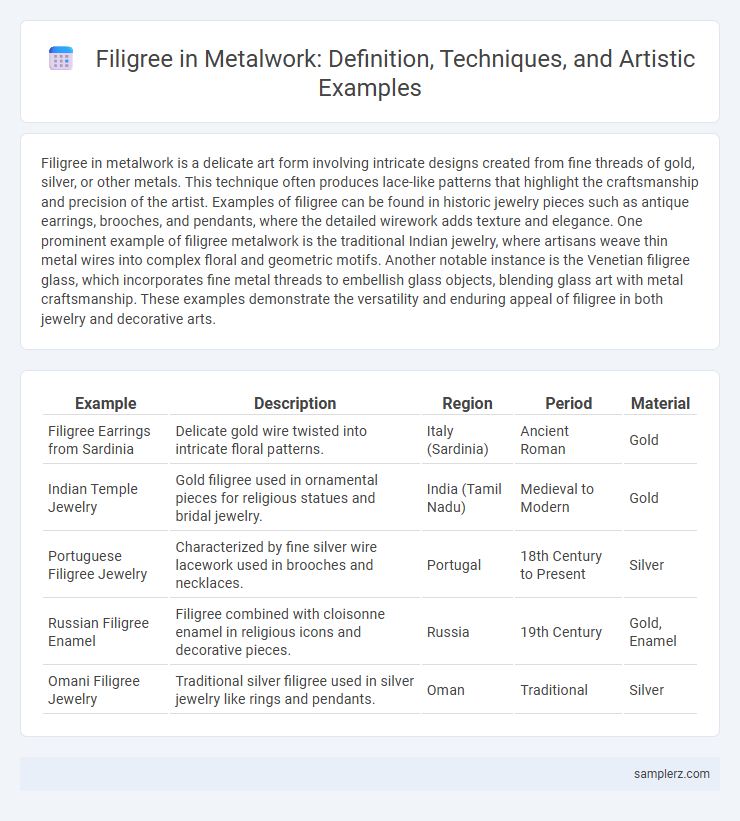Filigree in metalwork is a delicate art form involving intricate designs created from fine threads of gold, silver, or other metals. This technique often produces lace-like patterns that highlight the craftsmanship and precision of the artist. Examples of filigree can be found in historic jewelry pieces such as antique earrings, brooches, and pendants, where the detailed wirework adds texture and elegance. One prominent example of filigree metalwork is the traditional Indian jewelry, where artisans weave thin metal wires into complex floral and geometric motifs. Another notable instance is the Venetian filigree glass, which incorporates fine metal threads to embellish glass objects, blending glass art with metal craftsmanship. These examples demonstrate the versatility and enduring appeal of filigree in both jewelry and decorative arts.
Table of Comparison
| Example | Description | Region | Period | Material |
|---|---|---|---|---|
| Filigree Earrings from Sardinia | Delicate gold wire twisted into intricate floral patterns. | Italy (Sardinia) | Ancient Roman | Gold |
| Indian Temple Jewelry | Gold filigree used in ornamental pieces for religious statues and bridal jewelry. | India (Tamil Nadu) | Medieval to Modern | Gold |
| Portuguese Filigree Jewelry | Characterized by fine silver wire lacework used in brooches and necklaces. | Portugal | 18th Century to Present | Silver |
| Russian Filigree Enamel | Filigree combined with cloisonne enamel in religious icons and decorative pieces. | Russia | 19th Century | Gold, Enamel |
| Omani Filigree Jewelry | Traditional silver filigree used in silver jewelry like rings and pendants. | Oman | Traditional | Silver |
Introduction to Filigree in Metalwork
Filigree in metalwork showcases intricate designs crafted from fine threads of gold, silver, or other metals, twisted and soldered to create delicate lace-like patterns. This technique, dating back to ancient civilizations such as the Etruscans and Greeks, highlights exceptional craftsmanship in jewelry and decorative art. Modern artisans continue to explore filigree's versatility by combining traditional methods with contemporary motifs to produce stunning ornamental pieces.
Historical Origins of Filigree Techniques
Filigree in metalwork originated in ancient Mesopotamia and Egypt, where artisans used fine gold and silver wires to create intricate lace-like patterns. This technique flourished during the Hellenistic period, spreading through Greek and Etruscan cultures, with evidence found in jewelry and decorative objects. Filigree's historical origins trace back over 3,000 years, showcasing the meticulous craftsmanship characteristic of early metalworking traditions.
Filigree in Ancient Gold Jewelry
Filigree in ancient gold jewelry showcases intricate wirework techniques where fine gold threads are twisted and soldered to create delicate lace-like patterns, exemplified in Etruscan and Greek artifacts dating back to 7th century BCE. These pieces often feature motifs such as spirals, rosettes, and granulated beads, highlighting the craftsmanship and aesthetic sensibility of ancient metalworkers. The durability and brilliance of gold combined with meticulous filigree work resulted in jewelry that served both decorative and symbolic purposes across early Mediterranean cultures.
Silver Filigree Traditions Across Cultures
Silver filigree showcases intricate metalwork techniques prominent in cultures such as Indian, Italian, and Middle Eastern art. Indian silver filigree, known as Tarakasi, features fine wire motifs used in jewelry and decorative objects, while Italian filigree, especially from regions like Sardinia, emphasizes delicate lace-like patterns. Middle Eastern silver filigree often incorporates geometric and floral designs, reflecting Islamic artistic influences in traditional craftsmanship.
Iconic Filigree Artifacts from the Renaissance
Renaissance filigree metalwork showcases intricate designs exemplified by artifacts such as the Saliera by Benvenuto Cellini, combining gold and enamel in elaborate ornamental patterns. The use of fine gold wires twisted into delicate lace-like motifs exemplifies the mastery of Renaissance artisans, evident in jewelry pieces and religious artifacts from this period. These works highlight the era's emphasis on detailed craftsmanship and artistic expression in metal artistry.
Masterpieces of Filigree in Religious Objects
Masterpieces of filigree in religious objects showcase intricate metalwork using fine threads of gold and silver to create delicate, lace-like patterns. Notable examples include the Eastern Orthodox reliquaries and chalices adorned with complex filigree motifs, highlighting exceptional craftsmanship and spiritual symbolism. These artifacts demonstrate the fusion of artistic finesse and religious devotion across Byzantine and Indian temple traditions.
Contemporary Filigree in Modern Metal Art
Contemporary filigree in modern metal art exemplifies intricate craftsmanship with fine, twisted metal threads forming delicate lace-like patterns that blend traditional techniques with innovative designs. Artists such as William Spratling and Wallace Chan have pushed the boundaries by incorporating filigree into sculptural jewelry and large-scale installations, highlighting the precision and complexity achievable with advanced tools. This fusion of old-world artistry and modern aesthetics continues to redefine filigree as a dynamic element in contemporary metalwork.
Regional Styles: Filigree in Indian Metalwork
Indian filigree metalwork showcases intricate patterns crafted from fine gold or silver wires, often depicting floral and geometric motifs distinctive to regions like Odisha and Andhra Pradesh. The city of Cuttack in Odisha is renowned for its exquisite filigree jewelry and decorative items that highlight delicate craftsmanship passed down through generations. Andhra Pradesh's filigree pieces incorporate traditional designs with a contemporary touch, reflecting the region's rich cultural heritage and artisanal expertise.
Innovative Applications of Filigree Today
Innovative applications of filigree in metalwork today incorporate advanced techniques such as laser cutting and 3D printing, enabling intricate designs with unprecedented precision. Contemporary artists blend traditional filigree patterns with modern materials like titanium and stainless steel, enhancing durability and aesthetic appeal. This fusion revitalizes the ancient art form, expanding its use beyond jewelry to architectural elements and wearable tech.
Preservation and Restoration of Filigree Works
Preservation and restoration of filigree works require meticulous attention to maintain the intricate metal threads and delicate openwork patterns characteristic of this art form. Advanced techniques such as micro-welding and gentle ultrasonic cleaning are employed to stabilize fragile filigree structures without compromising their original design. Conservation efforts prioritize using reversible materials and detailed documentation to protect historic filigree jewelry and artifacts for future generations.

example of filigree in metalwork Infographic
 samplerz.com
samplerz.com